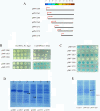Structural/functional analysis of the human OXR1 protein: identification of exon 8 as the anti-oxidant encoding function
- PMID: 22873401
- PMCID: PMC3462732
- DOI: 10.1186/1471-2199-13-26
Structural/functional analysis of the human OXR1 protein: identification of exon 8 as the anti-oxidant encoding function
Abstract
Background: The human OXR1 gene belongs to a class of genes with conserved functions that protect cells from reactive oxygen species (ROS). The gene was found using a screen of a human cDNA library by its ability to suppress the spontaneous mutator phenotype of an E. coli mutH nth strain. The function of OXR1 is unknown. The human and yeast genes are induced by oxidative stress and targeted to the mitochondria; the yeast gene is required for resistance to hydrogen peroxide. Multiple spliced isoforms are expressed in a variety of human tissues, including brain.
Results: In this report, we use a papillation assay that measures spontaneous mutagenesis of an E. coli mutM mutY strain, a host defective for oxidative DNA repair. Papillation frequencies with this strain are dependent upon a G→T transversion in the lacZ gene (a mutation known to occur as a result of oxidative damage) and are suppressed by in vivo expression of human OXR1. N-terminal, C-terminal and internal deletions of the OXR1 gene were constructed and tested for suppression of the mutagenic phenotype of the mutM mutY strain. We find that the TLDc domain, encoded by the final four exons of the OXR1 gene, is not required for papillation suppression in E. coli. Instead, we show that the protein segment encoded by exon 8 of OXR1 is responsible for the suppression of oxidative damage in E. coli.
Conclusion: The protein segment encoded by OXR1 exon 8 plays an important role in the anti-oxidative function of the human OXR1 protein. This result suggests that the TLDc domain, found in OXR1 exons 12-16 and common in many proteins with nuclear function, has an alternate (undefined) role other than oxidative repair.
Figures







Similar articles
-
The OXR domain defines a conserved family of eukaryotic oxidation resistance proteins.BMC Cell Biol. 2007 Mar 28;8:13. doi: 10.1186/1471-2121-8-13. BMC Cell Biol. 2007. PMID: 17391516 Free PMC article.
-
Stress induction and mitochondrial localization of Oxr1 proteins in yeast and humans.Mol Cell Biol. 2004 Apr;24(8):3180-7. doi: 10.1128/MCB.24.8.3180-3187.2004. Mol Cell Biol. 2004. PMID: 15060142 Free PMC article.
-
Functional genomics reveals a family of eukaryotic oxidation protection genes.Proc Natl Acad Sci U S A. 2000 Dec 19;97(26):14530-5. doi: 10.1073/pnas.260495897. Proc Natl Acad Sci U S A. 2000. PMID: 11114193 Free PMC article.
-
The OGG1 gene encodes a repair enzyme for oxidatively damaged DNA and is involved in human carcinogenesis.Antioxid Redox Signal. 2001 Aug;3(4):597-609. doi: 10.1089/15230860152542952. Antioxid Redox Signal. 2001. PMID: 11554447 Review.
-
Preventing Neurodegeneration by Controlling Oxidative Stress: The Role of OXR1.Front Neurosci. 2020 Dec 15;14:611904. doi: 10.3389/fnins.2020.611904. eCollection 2020. Front Neurosci. 2020. PMID: 33384581 Free PMC article. Review.
Cited by
-
The Evolutionarily Conserved Tre2/Bub2/Cdc16 (TBC), Lysin Motif (LysM), Domain Catalytic (TLDc) Domain Is Neuroprotective against Oxidative Stress.J Biol Chem. 2016 Feb 5;291(6):2751-63. doi: 10.1074/jbc.M115.685222. Epub 2015 Dec 14. J Biol Chem. 2016. PMID: 26668325 Free PMC article.
-
Pediatric-Onset Epilepsy and Developmental Epileptic Encephalopathies Followed by Early-Onset Parkinsonism.Int J Mol Sci. 2023 Feb 14;24(4):3796. doi: 10.3390/ijms24043796. Int J Mol Sci. 2023. PMID: 36835207 Free PMC article. Review.
-
TBC1D24 genotype-phenotype correlation: Epilepsies and other neurologic features.Neurology. 2016 Jul 5;87(1):77-85. doi: 10.1212/WNL.0000000000002807. Epub 2016 Jun 8. Neurology. 2016. PMID: 27281533 Free PMC article.
-
Oxidation resistance 1 prevents genome instability through maintenance of G2/M arrest in gamma-ray-irradiated cells.J Radiat Res. 2020 Jan 23;61(1):1-13. doi: 10.1093/jrr/rrz080. J Radiat Res. 2020. PMID: 31845986 Free PMC article.
-
Induction of a unique isoform of the NCOA7 oxidation resistance gene by interferon β-1b.J Interferon Cytokine Res. 2015 Mar;35(3):186-99. doi: 10.1089/jir.2014.0115. Epub 2014 Oct 20. J Interferon Cytokine Res. 2015. PMID: 25330068 Free PMC article.
References
-
- Hancock JT, Desikan R, Neill SJ. Role of reactive oxygen species in cell signalling pathways. Biochem Soc Trans. 2001;29(Pt 2):345–350. - PubMed
Publication types
MeSH terms
Substances
Grants and funding
LinkOut - more resources
Full Text Sources
Molecular Biology Databases
Research Materials
Miscellaneous

